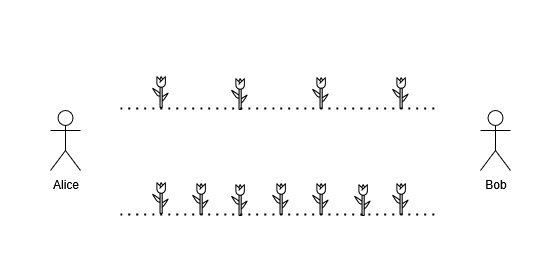3021. Alice and Bob Playing Flower Game
Description
Alice and Bob are playing a turn-based game on a field, with two lanes of flowers between them. There are x flowers in the first lane between Alice and Bob, and y flowers in the second lane between them.

The game proceeds as follows:
- Alice takes the first turn.
- In each turn, a player must choose either one of the lane and pick one flower from that side.
- At the end of the turn, if there are no flowers left at all, the current player captures their opponent and wins the game.
Given two integers, n and m, the task is to compute the number of possible pairs (x, y) that satisfy the conditions:
- Alice must win the game according to the described rules.
- The number of flowers
xin the first lane must be in the range[1,n]. - The number of flowers
yin the second lane must be in the range[1,m].
Return the number of possible pairs (x, y) that satisfy the conditions mentioned in the statement.
Example 1:
Input: n = 3, m = 2 Output: 3 Explanation: The following pairs satisfy conditions described in the statement: (1,2), (3,2), (2,1).
Example 2:
Input: n = 1, m = 1 Output: 0 Explanation: No pairs satisfy the conditions described in the statement.
Constraints:
1 <= n, m <= 105
Solutions
Solution: Math
- Time complexity: O(1)
- Space complexity: O(1)
JavaScript
js
/**
* @param {number} n
* @param {number} m
* @return {number}
*/
const flowerGame = function (n, m) {
const countEvenN = Math.floor(n / 2);
const countOddN = n - countEvenN;
const countEvenM = Math.floor(m / 2);
const countOddM = m - countEvenM;
return countOddN * countEvenM + countEvenN * countOddM;
};